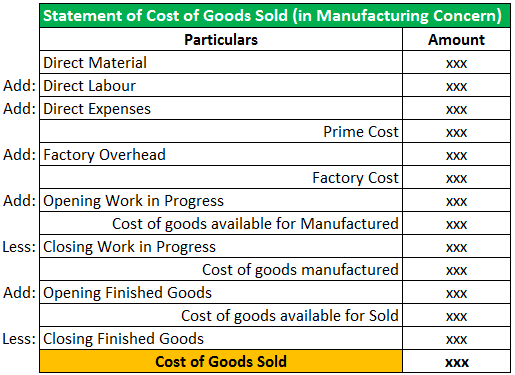COGS Simplified: Record Your Cost of Goods Sold Journal Entry Effortlessly

As prices increase, the business’s net income may increase as well. This process may result in a lower cost of goods sold calculation compared to the LIFO method. Beyond that, tracking accurate costs of your inventory helps you calculate your true inventory value, or the total dollar value of inventory you have in stock. Typically, once you determine cost of goods sold, it’ll help you determine how much you owe in taxes at the end of the reporting period—usually 12 months. COGS can also help you determine the value of your inventory for calculating business assets. The figure for the cost of goods sold only includes the costs for the items sold during the period and not the finished goods that are not still sold or billed by customers.

How COGS journal entries fit into your bookkeeping system
Depending on the business’s size, type of business license, and inventory valuation, the CRA may require a specific inventory costing method. However, once a business chooses a costing method, it should remain consistent with that method year over year. Consistency helps businesses stay compliant with generally accepted accounting principles (GAAP). However, some companies with inventory may use a multi-step income statement. COGS appears in the same place, but net income is computed differently. For multi-step income statements, subtract the cost of goods sold from sales.
How Often Should You Record COGS in Your Ecommerce Business?
Labor costs can also be reduced by finding ways to automate or outsource labor-intensive functions and renegotiating wages, hours, and benefits. This can help businesses increase their efficiency and reduce overhead expenses. While our 40% margin is standard for our industry, our competitors are outperforming us with 50%+ margins on similar products. We know that there is consumer demand so how do we improve our margins? Should we increase marketing efforts and focus on pushing higher-margin products?
Cost of goods sold under perpetual inventory system
- For another example, assuming that we still use the periodic inventory system and we still have the beginning inventory of $50,000 on the previous year’s balance sheet.
- The basic costs of good sold journal entry for inventory purchases involves a debit and a credit.
- And during the current year, we still have a total purchase of $200,000.
- However, some items’ cost may not be easily identified or may be too closely intermingled, such as when making bulk batches of items.
Recording a COGS journal entry is a relatively straightforward process. And the ending inventory is $10,000 ($50,000 – $40,000) less than the beginning inventory. This means that the inventory balance decreased by $10,000 compared to the previous year.
Uses of COGS in Other Formulas
These costs can include materials as well as the staff required to assemble the materials into finished sellable goods. No matter how COGS is recorded, keep regular records of your COGS calculations. Like most business expenses, records can help you prove your calculations are accurate in case of an audit. Plus, your accountant will appreciate detailed records come tax time.
Cost of goods sold on an income statement
Debit the factory overhead account and credit the raw materials inventory asset account. At the end of the month, the ending balance in the overhead account is allocated to the cost of goods sold and ending inventory. Raw materials inventory is the total cost of all component parts currently in stock that have not yet been used in work-in-process or finished goods production. Raw materials may be aggregated into a single inventory line item in the balance sheet that also includes the cost of work-in-process and finished goods inventory. In accounting, the inventory turnover is a measure of the number of times inventory is sold or used in a time period such as a year.
Always keep a keen eye on these figures because they shape how much gross profit a company reports. Accurate COGS ensures you know the true financial health of the business. Make sure they match up with receipts, invoices, and other financial records. Track every piece of equipment used, from giant conveyor belts to the smallest drill bit. For instance, if your company makes furniture, the wood becomes part of inventory costs while saws and sanders are counted as manufacturing expenses. Business owners use this data when planning budgets and forecasting future expenses.
In accounting, we usually need to make a journal entry to record the cost of goods sold after the sale of such goods or products if we use the perpetual inventory system in our company. When it’s time to tackle your journal entries for COGS, the essential elements are your debits and credits that illustrate the ebb and flow of your inventory costs. On one side, you’ll how to record cost of goods sold journal entry debit your COGS account, thereby increasing the expenses on your income statement. This debit reflects the cost of goods that have left the sanctuary of your stockroom in the arms of customers. If you are operating a production facility, then the warehouse staff will pick raw materials from stock and shift it to the production floor, possibly by job number.
